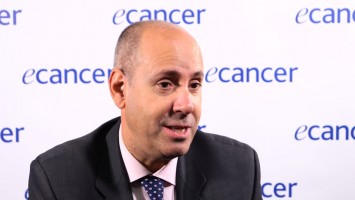Inavolisib, palbociclib, fulvestrant combo shows sustained benefit beyond disease progression in HER2‑negative metastatic breast cancer
Dr Dejan Juric - Massachusetts General Hospital, Boston, USA
I’m excited to talk about the INAVO120 clinical trial results. We presented an expanded analysis of this trial starting with the progression free survival data that I just want to reiterate that provides compelling evidence that this triple combination of inavolisib, a novel PI3 kinase alpha inhibitor, plus palbociclib plus fulvestrant prolongs progression free survival from 7.3 months to 15 months, essentially more than doubling progression free survival. The benefit was even more compelling in premenopausal patients, going from 6.5 to 20 months and that was associated with improvement in objective response rate, going from 25% to almost 60% which is quite compelling.
What is interesting about the presentation here at ASCO is that we added more detail about patient experience during the clinical trial. What was interesting to see is that the patients report through various patient reported outcome assessments that there is significant delay in deterioration of their pain. So more than 12.8 months, more than a year later, patients have increase in their pain with the triplet combination compared to the doublet combination, the combination with placebo. In addition to that we see that their quality of life, day-to-day functioning, is completely maintained and there is minimal increase in the overall bother that’s associated with the treatment itself.
When you look at individual side effects, just to get a little bit more granularity about what’s happening, you see the most common on-target side effects of PI3 kinase inhibitors are actually much less pronounced with inavolisib. What we see, for example for hypoglycaemia, only 1.2% of patients discontinue their therapy for that side effect, increased blood glucose, that’s five times less than what we see with earlier generations of PI3 kinase inhibitors, inhibitors that are currently available. In addition, there is 0% discontinuation for rash; again this is really important because patients with alpelisib, the earlier generation PI3 kinase inhibitors, have a great deal of difficulties with rash. Similar results we see with diarrhoea, 0% of patients have to discontinue for diarrhoea and there was only about 0.6% for stomatitis.
So, overall, when you look at these side effects and you see that patients do not have to discontinue therapy which means that then adverse management guidelines are really working. This is a message that I also want to send, and that I clarified during the presentation: when you start triple therapy you’re hoping to prevent a whack-a-mole game, so to speak. You’re trying to squeeze the cancer at three different molecular switches – PI3 kinase, ER, oestrogen receptor, and CDK4/6. So you’re closing the door for cancer to escape but when you do that you always worry you’re now adding not one, not two but three different agents, you worry about side effects. So when you see that the patients actually can tolerate this and you have then doubling of progression free survival and maintenance of their quality of life, that’s really the combination that we are looking for.
I believe sincerely that in patients who are high risk, patients who are progressing shortly on or shortly after adjuvant therapy, patients who have measurable disease, particularly visceral involvement and who have a PI3 kinase mutation, a particularly bad prognostic sign, when you have those features it’s going to be really important that this triple combination is used in those patients. The drug just last month received breakthrough therapy designation and it certainly holds a great deal of promise for this patient population.








